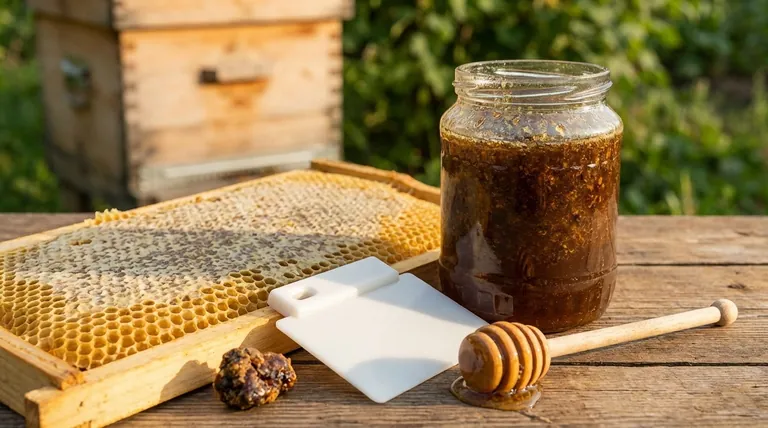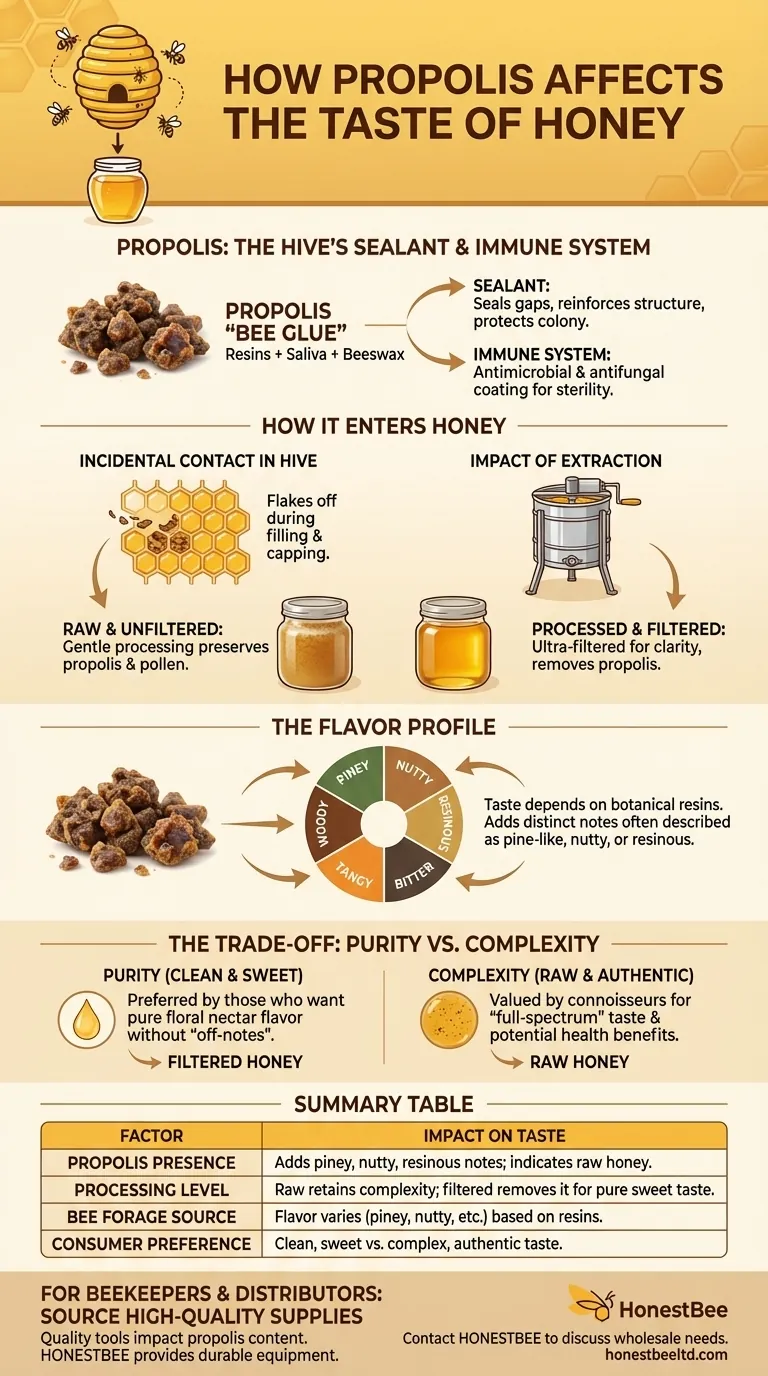When present in honey, propolis can impart a distinct flavor profile, often described as a subtle pine-like, nutty, or even slightly resinous taste. This occurs when the compound, a sticky substance bees use to build and protect their hive, incidentally mixes with the honey during storage or extraction.
The presence of propolis in honey is not a sign of contamination but a hallmark of a raw, minimally processed product. Its unique flavor notes are often valued by connoisseurs as an indicator of authenticity and complexity.

What is Propolis?
Propolis, often called "bee glue," is a critical substance for the health and integrity of a beehive. Understanding its purpose clarifies why it can end up in honey.
The Hive's Natural Sealant
Bees create propolis by collecting resins from tree buds and other botanical sources. They mix these resins with their own saliva and beeswax to produce a sticky, powerful sealant.
Its primary functions are to seal unwanted gaps in the hive, reinforce the honeycomb structure, and protect the colony from external threats.
The Colony's Immune System
Beyond its structural use, propolis has potent antimicrobial and antifungal properties. The bees coat the inside of the hive with it to create a sterile environment, effectively serving as the colony's external immune system.
How Propolis Alters Honey's Taste
The transfer of propolis to honey is a natural process, influenced primarily by proximity and the method of honey extraction.
Incidental Contact in the Hive
Bees use propolis extensively around the honeycomb. During the process of filling cells with honey and capping them with wax, small particles of propolis can flake off or be transferred into the nectar.
The Impact of Extraction
Raw and unfiltered honey is often extracted without high heat or fine-mesh filters. This gentle processing preserves natural components, including trace amounts of propolis and pollen, which contribute to a more complex flavor.
In contrast, highly processed commercial honey is typically ultra-filtered to create a crystal-clear product with a uniform taste. This process removes propolis entirely, along with pollen and other beneficial compounds.
The Resulting Flavor Profile
The taste propolis imparts is directly related to the botanical resins the bees collected. If bees foraged from pine trees, the resulting propolis can lend a piney or woody note to the honey. Other sources can create flavors described as nutty, slightly bitter, or even tangy.
Understanding the Trade-offs
Whether propolis is a desirable component in honey depends entirely on your goal as a consumer or producer. There is no single "best" answer, only different preferences.
The Case for Purity
Many people prefer a honey that is exceptionally clean and sweet, where the flavor is determined solely by the floral nectar source (e.g., clover, orange blossom). For this audience, any additional flavor from propolis can be seen as an off-note or an impurity that masks the pure floral taste.
The Case for Complexity
Conversely, many honey aficionados and health-conscious consumers seek out raw honey specifically for its complexity. They value the slightly bitter, resinous, or nutty undertones from propolis as a sign of a "full-spectrum" honey that has not been stripped of its natural character.
Making the Right Choice for Your Goal
Your ideal honey depends on whether you prioritize a pure, sweet flavor or a complex, raw product. Use this framework to guide your selection.
- If your primary focus is a pure, sweet taste: Look for honey that is labeled "filtered" or appears very clear. These products have had particulates like propolis removed for a cleaner, more straightforward flavor.
- If your primary focus is complexity and potential health benefits: Choose honey labeled "raw" or "unfiltered." A subtle piney or nutty note is a good indicator that the honey has been minimally processed, retaining its natural components.
- If you are a beekeeper: Be aware that your extraction methods directly impact the final flavor. Less aggressive filtering will result in a more complex honey that retains the character of the hive, including its propolis.
Ultimately, understanding the role of propolis empowers you to appreciate the story behind each jar of honey and select the one that best suits your palate.
Summary Table:
| Factor | Impact on Honey Taste |
|---|---|
| Propolis Presence | Adds piney, nutty, or resinous notes; indicates raw, unfiltered honey. |
| Processing Level | Raw/unfiltered retains propolis for complexity; filtered/processed removes it for a pure, sweet taste. |
| Bee Forage Source | Flavor varies (e.g., piney from pine resins, nutty from other botanicals). |
| Consumer Preference | Clean, sweet flavor vs. complex, authentic taste with potential health benefits. |
For Beekeepers and Distributors: Source High-Quality Beekeeping Supplies
Whether you manage a commercial apiary or supply beekeeping equipment to others, the quality of your tools directly impacts honey characteristics like propolis content. HONESTBEE provides durable, reliable beekeeping supplies and equipment through wholesale-focused operations, helping you produce superior honey.
Contact HONESTBEE today to discuss your needs and learn how our products support beekeeping excellence.
Visual Guide

Related Products
- Professional Wide Blade Honey Scraper for Beekeeping and Honey Processing
- Professional Long-Handled Silicone Honey Scraper for Beekeeping
- Honey Wax Separating Wax Press with Metal Screw Wax Separator Machine
- Stainless Steel Honey Press Wax Press with Tank
- Stainless Steel Pail Perch Bucket Bench
People Also Ask
- Why are my bees not capping honey? Understand the Key to Perfect Honey Ripening
- Why is my honey frame not capped? Your Guide to Perfectly Ripe Honey
- What tools are available for uncapping honey? A Guide to Choosing the Right Tool for Your Operation
- What are wax cappings in the context of honey extraction? The Beekeeper's Guide to a Second Harvest
- How can a capping scratcher be used with an electric knife? Boost Efficiency and Honey Yield



















